HNN217: Primary Healthcare Nursing Roles in HIV/AIDS Prevention
VerifiedAdded on 2023/01/12
|9
|3309
|53
Essay
AI Summary
This essay delves into the crucial roles of primary healthcare nurses in preventing HIV/AIDS among at-risk populations. It explores the concept of primary healthcare, emphasizing the comprehensive approach to patient care from birth to death, and highlights the diverse roles nurses play in various settings. The essay discusses HIV/AIDS, its transmission, symptoms, and the impact on individuals and families. It emphasizes the significance of nursing interventions, including education, testing, and treatment, and the importance of nurses in providing care, support, and promoting adherence to treatment. The essay also covers risk reduction strategies, the role of nurses in hospitals and community settings, and the challenges nurses face in managing HIV/AIDS patients. Furthermore, it discusses long-term survival, multimorbidities, and the application of interventions like AIMS to improve patient outcomes. Ultimately, the essay underscores the vital contribution of nurses in the prevention, management, and overall well-being of individuals affected by HIV/AIDS.
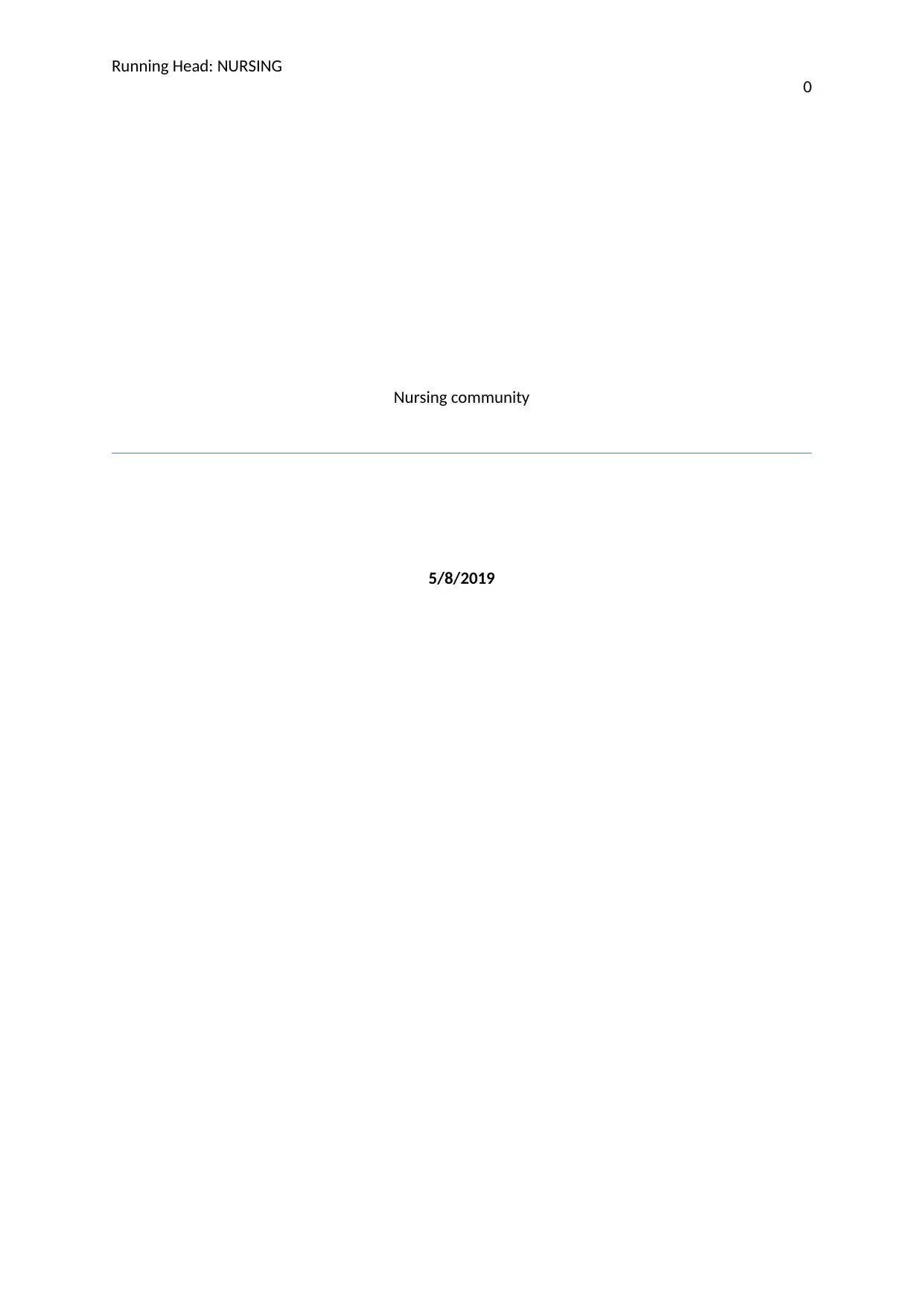
Running Head: NURSING
0
Nursing community
5/8/2019
0
Nursing community
5/8/2019
Paraphrase This Document
Need a fresh take? Get an instant paraphrase of this document with our AI Paraphraser
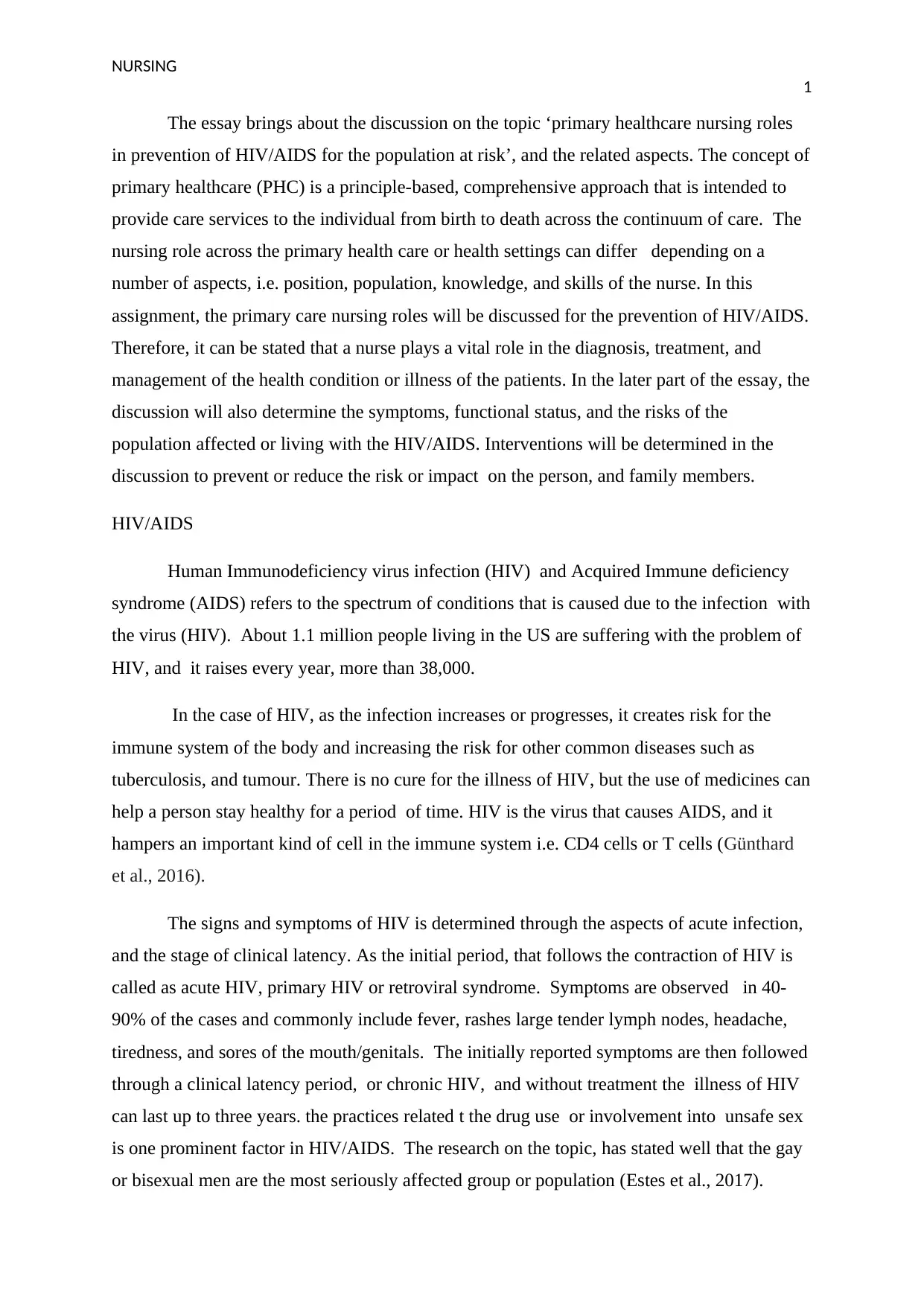
NURSING
1
The essay brings about the discussion on the topic ‘primary healthcare nursing roles
in prevention of HIV/AIDS for the population at risk’, and the related aspects. The concept of
primary healthcare (PHC) is a principle-based, comprehensive approach that is intended to
provide care services to the individual from birth to death across the continuum of care. The
nursing role across the primary health care or health settings can differ depending on a
number of aspects, i.e. position, population, knowledge, and skills of the nurse. In this
assignment, the primary care nursing roles will be discussed for the prevention of HIV/AIDS.
Therefore, it can be stated that a nurse plays a vital role in the diagnosis, treatment, and
management of the health condition or illness of the patients. In the later part of the essay, the
discussion will also determine the symptoms, functional status, and the risks of the
population affected or living with the HIV/AIDS. Interventions will be determined in the
discussion to prevent or reduce the risk or impact on the person, and family members.
HIV/AIDS
Human Immunodeficiency virus infection (HIV) and Acquired Immune deficiency
syndrome (AIDS) refers to the spectrum of conditions that is caused due to the infection with
the virus (HIV). About 1.1 million people living in the US are suffering with the problem of
HIV, and it raises every year, more than 38,000.
In the case of HIV, as the infection increases or progresses, it creates risk for the
immune system of the body and increasing the risk for other common diseases such as
tuberculosis, and tumour. There is no cure for the illness of HIV, but the use of medicines can
help a person stay healthy for a period of time. HIV is the virus that causes AIDS, and it
hampers an important kind of cell in the immune system i.e. CD4 cells or T cells (Günthard
et al., 2016).
The signs and symptoms of HIV is determined through the aspects of acute infection,
and the stage of clinical latency. As the initial period, that follows the contraction of HIV is
called as acute HIV, primary HIV or retroviral syndrome. Symptoms are observed in 40-
90% of the cases and commonly include fever, rashes large tender lymph nodes, headache,
tiredness, and sores of the mouth/genitals. The initially reported symptoms are then followed
through a clinical latency period, or chronic HIV, and without treatment the illness of HIV
can last up to three years. the practices related t the drug use or involvement into unsafe sex
is one prominent factor in HIV/AIDS. The research on the topic, has stated well that the gay
or bisexual men are the most seriously affected group or population (Estes et al., 2017).
1
The essay brings about the discussion on the topic ‘primary healthcare nursing roles
in prevention of HIV/AIDS for the population at risk’, and the related aspects. The concept of
primary healthcare (PHC) is a principle-based, comprehensive approach that is intended to
provide care services to the individual from birth to death across the continuum of care. The
nursing role across the primary health care or health settings can differ depending on a
number of aspects, i.e. position, population, knowledge, and skills of the nurse. In this
assignment, the primary care nursing roles will be discussed for the prevention of HIV/AIDS.
Therefore, it can be stated that a nurse plays a vital role in the diagnosis, treatment, and
management of the health condition or illness of the patients. In the later part of the essay, the
discussion will also determine the symptoms, functional status, and the risks of the
population affected or living with the HIV/AIDS. Interventions will be determined in the
discussion to prevent or reduce the risk or impact on the person, and family members.
HIV/AIDS
Human Immunodeficiency virus infection (HIV) and Acquired Immune deficiency
syndrome (AIDS) refers to the spectrum of conditions that is caused due to the infection with
the virus (HIV). About 1.1 million people living in the US are suffering with the problem of
HIV, and it raises every year, more than 38,000.
In the case of HIV, as the infection increases or progresses, it creates risk for the
immune system of the body and increasing the risk for other common diseases such as
tuberculosis, and tumour. There is no cure for the illness of HIV, but the use of medicines can
help a person stay healthy for a period of time. HIV is the virus that causes AIDS, and it
hampers an important kind of cell in the immune system i.e. CD4 cells or T cells (Günthard
et al., 2016).
The signs and symptoms of HIV is determined through the aspects of acute infection,
and the stage of clinical latency. As the initial period, that follows the contraction of HIV is
called as acute HIV, primary HIV or retroviral syndrome. Symptoms are observed in 40-
90% of the cases and commonly include fever, rashes large tender lymph nodes, headache,
tiredness, and sores of the mouth/genitals. The initially reported symptoms are then followed
through a clinical latency period, or chronic HIV, and without treatment the illness of HIV
can last up to three years. the practices related t the drug use or involvement into unsafe sex
is one prominent factor in HIV/AIDS. The research on the topic, has stated well that the gay
or bisexual men are the most seriously affected group or population (Estes et al., 2017).

NURSING
2
Discussing the transmission of HIV it has been found that a person gets HIV through unsafe
sex or unprotected sex with their partners. It may also spread through sharing of the needles,
or syringes for shooting drugs, and tattoos.
The above diagram from the recent yeas, has stated the ratio between male and female
in context to the cause, and medium of transmission of HIV from one person to another.
Moreover, it has been found that the youth or young people are at a high risk of
developing HIV/AIDS infection. Therefore, in a concise manner the mode of transmission of
HIV infection is observed, from mother-to-child, body fluids or semen, and sexual contact .
Therefore, the medium of transmission of the infection through HOV/AIDS has been
described well. Now, the further section of this essay will the assessment of the nursing roles
available for management of ill-health of the person (Cohn et al., 2016).
Discussing the roles and responsibilities of the community health nurse, or public
health nurse is vital to their practice, and treatment. This also includes the factor of education
which is equally important for the individuals, families, and carers. it has been found that the
primary care in nursing can support the aspect of HIV prevention by providing a well-
targeted HIV testing of the people at risk. after the testing, when a HIV positive patient
receives a diagnosis, the nurse in the healthcare initiates their process of HIV treatment as
early as possible. As early treatment of the people at risk of HIV will benefit the patients,
and also help in reducing the risk of passing HIV to others (Bekker et al., 2015).
2
Discussing the transmission of HIV it has been found that a person gets HIV through unsafe
sex or unprotected sex with their partners. It may also spread through sharing of the needles,
or syringes for shooting drugs, and tattoos.
The above diagram from the recent yeas, has stated the ratio between male and female
in context to the cause, and medium of transmission of HIV from one person to another.
Moreover, it has been found that the youth or young people are at a high risk of
developing HIV/AIDS infection. Therefore, in a concise manner the mode of transmission of
HIV infection is observed, from mother-to-child, body fluids or semen, and sexual contact .
Therefore, the medium of transmission of the infection through HOV/AIDS has been
described well. Now, the further section of this essay will the assessment of the nursing roles
available for management of ill-health of the person (Cohn et al., 2016).
Discussing the roles and responsibilities of the community health nurse, or public
health nurse is vital to their practice, and treatment. This also includes the factor of education
which is equally important for the individuals, families, and carers. it has been found that the
primary care in nursing can support the aspect of HIV prevention by providing a well-
targeted HIV testing of the people at risk. after the testing, when a HIV positive patient
receives a diagnosis, the nurse in the healthcare initiates their process of HIV treatment as
early as possible. As early treatment of the people at risk of HIV will benefit the patients,
and also help in reducing the risk of passing HIV to others (Bekker et al., 2015).
⊘ This is a preview!⊘
Do you want full access?
Subscribe today to unlock all pages.

Trusted by 1+ million students worldwide
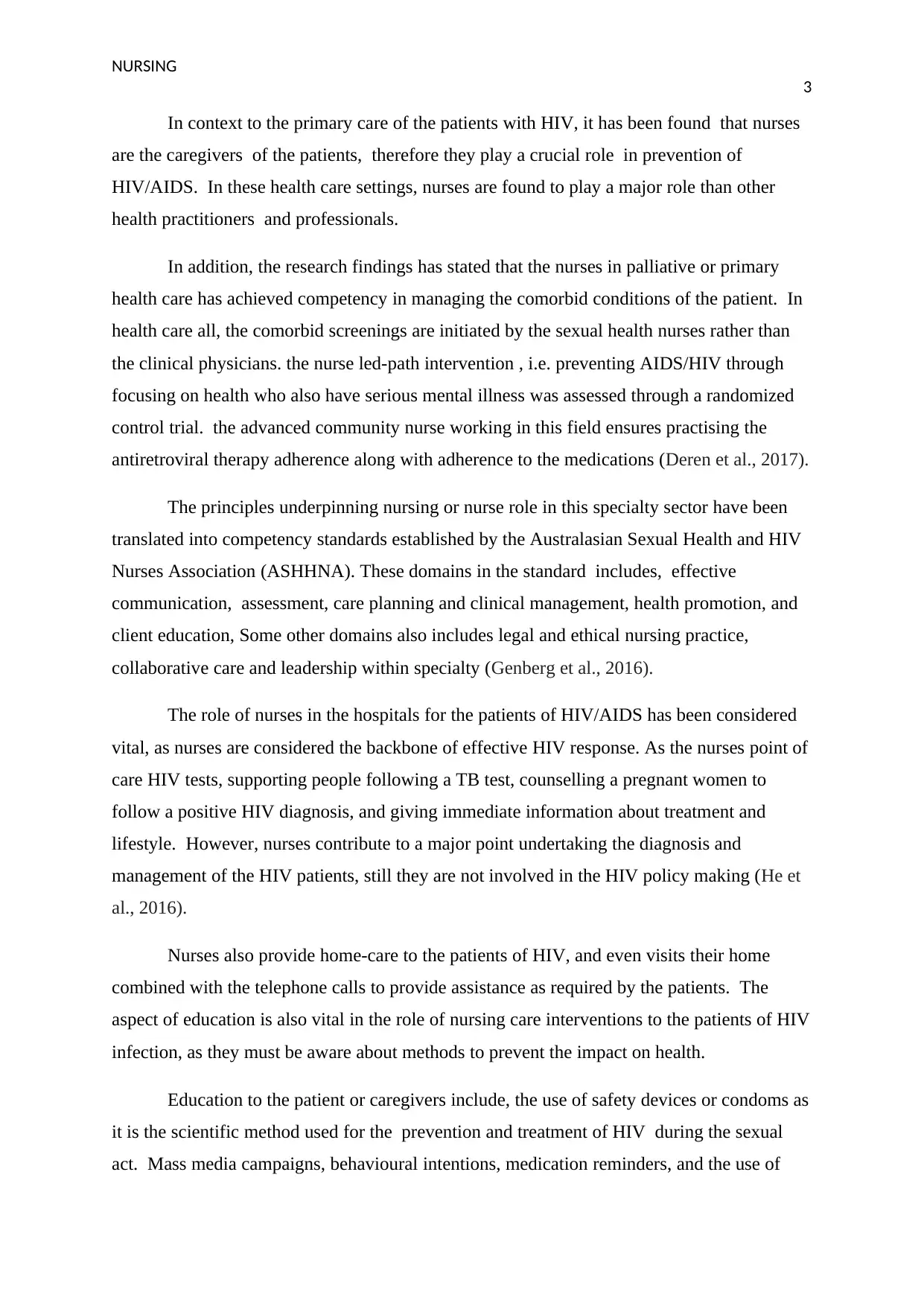
NURSING
3
In context to the primary care of the patients with HIV, it has been found that nurses
are the caregivers of the patients, therefore they play a crucial role in prevention of
HIV/AIDS. In these health care settings, nurses are found to play a major role than other
health practitioners and professionals.
In addition, the research findings has stated that the nurses in palliative or primary
health care has achieved competency in managing the comorbid conditions of the patient. In
health care all, the comorbid screenings are initiated by the sexual health nurses rather than
the clinical physicians. the nurse led-path intervention , i.e. preventing AIDS/HIV through
focusing on health who also have serious mental illness was assessed through a randomized
control trial. the advanced community nurse working in this field ensures practising the
antiretroviral therapy adherence along with adherence to the medications (Deren et al., 2017).
The principles underpinning nursing or nurse role in this specialty sector have been
translated into competency standards established by the Australasian Sexual Health and HIV
Nurses Association (ASHHNA). These domains in the standard includes, effective
communication, assessment, care planning and clinical management, health promotion, and
client education, Some other domains also includes legal and ethical nursing practice,
collaborative care and leadership within specialty (Genberg et al., 2016).
The role of nurses in the hospitals for the patients of HIV/AIDS has been considered
vital, as nurses are considered the backbone of effective HIV response. As the nurses point of
care HIV tests, supporting people following a TB test, counselling a pregnant women to
follow a positive HIV diagnosis, and giving immediate information about treatment and
lifestyle. However, nurses contribute to a major point undertaking the diagnosis and
management of the HIV patients, still they are not involved in the HIV policy making (He et
al., 2016).
Nurses also provide home-care to the patients of HIV, and even visits their home
combined with the telephone calls to provide assistance as required by the patients. The
aspect of education is also vital in the role of nursing care interventions to the patients of HIV
infection, as they must be aware about methods to prevent the impact on health.
Education to the patient or caregivers include, the use of safety devices or condoms as
it is the scientific method used for the prevention and treatment of HIV during the sexual
act. Mass media campaigns, behavioural intentions, medication reminders, and the use of
3
In context to the primary care of the patients with HIV, it has been found that nurses
are the caregivers of the patients, therefore they play a crucial role in prevention of
HIV/AIDS. In these health care settings, nurses are found to play a major role than other
health practitioners and professionals.
In addition, the research findings has stated that the nurses in palliative or primary
health care has achieved competency in managing the comorbid conditions of the patient. In
health care all, the comorbid screenings are initiated by the sexual health nurses rather than
the clinical physicians. the nurse led-path intervention , i.e. preventing AIDS/HIV through
focusing on health who also have serious mental illness was assessed through a randomized
control trial. the advanced community nurse working in this field ensures practising the
antiretroviral therapy adherence along with adherence to the medications (Deren et al., 2017).
The principles underpinning nursing or nurse role in this specialty sector have been
translated into competency standards established by the Australasian Sexual Health and HIV
Nurses Association (ASHHNA). These domains in the standard includes, effective
communication, assessment, care planning and clinical management, health promotion, and
client education, Some other domains also includes legal and ethical nursing practice,
collaborative care and leadership within specialty (Genberg et al., 2016).
The role of nurses in the hospitals for the patients of HIV/AIDS has been considered
vital, as nurses are considered the backbone of effective HIV response. As the nurses point of
care HIV tests, supporting people following a TB test, counselling a pregnant women to
follow a positive HIV diagnosis, and giving immediate information about treatment and
lifestyle. However, nurses contribute to a major point undertaking the diagnosis and
management of the HIV patients, still they are not involved in the HIV policy making (He et
al., 2016).
Nurses also provide home-care to the patients of HIV, and even visits their home
combined with the telephone calls to provide assistance as required by the patients. The
aspect of education is also vital in the role of nursing care interventions to the patients of HIV
infection, as they must be aware about methods to prevent the impact on health.
Education to the patient or caregivers include, the use of safety devices or condoms as
it is the scientific method used for the prevention and treatment of HIV during the sexual
act. Mass media campaigns, behavioural intentions, medication reminders, and the use of
Paraphrase This Document
Need a fresh take? Get an instant paraphrase of this document with our AI Paraphraser
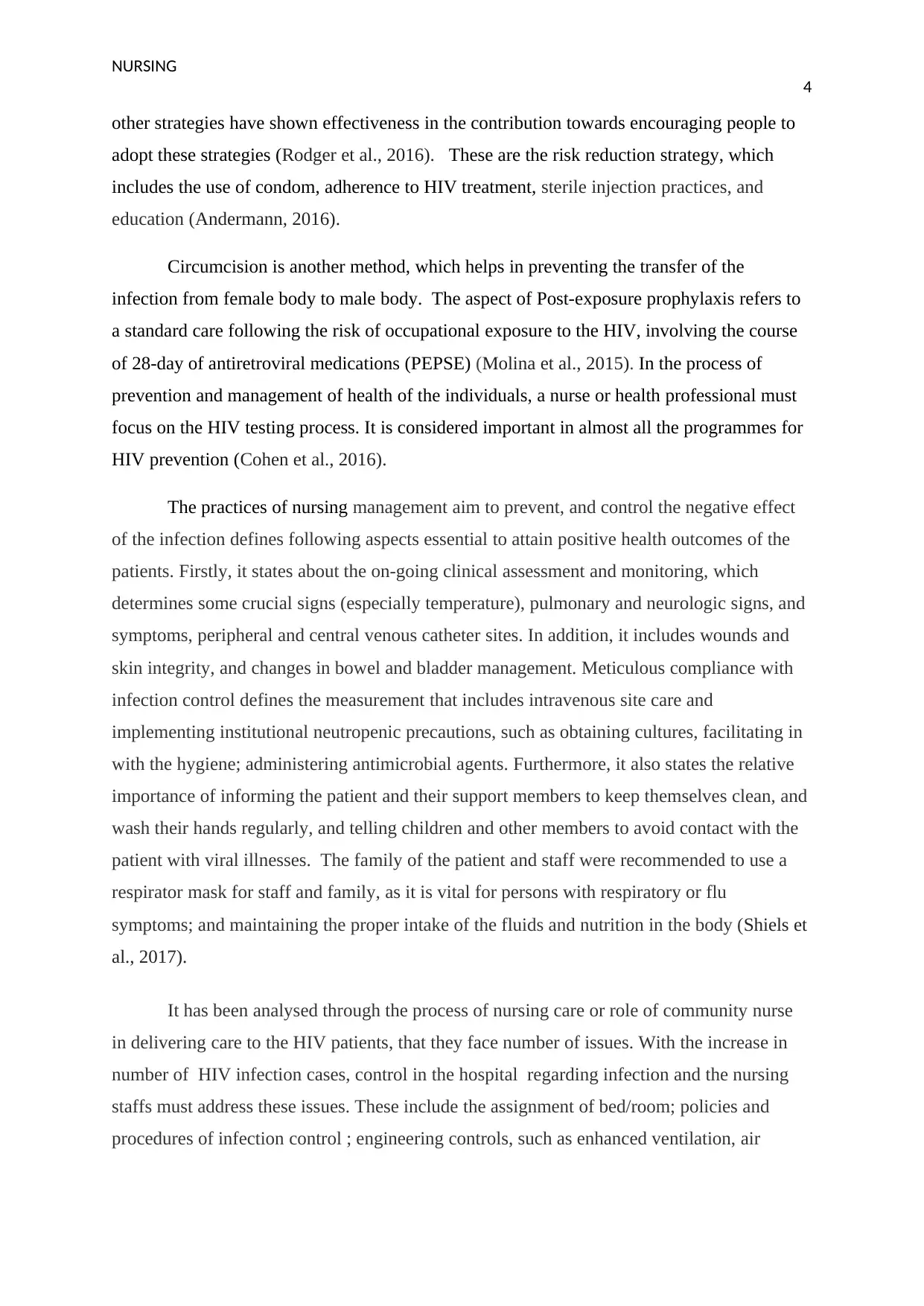
NURSING
4
other strategies have shown effectiveness in the contribution towards encouraging people to
adopt these strategies (Rodger et al., 2016). These are the risk reduction strategy, which
includes the use of condom, adherence to HIV treatment, sterile injection practices, and
education (Andermann, 2016).
Circumcision is another method, which helps in preventing the transfer of the
infection from female body to male body. The aspect of Post-exposure prophylaxis refers to
a standard care following the risk of occupational exposure to the HIV, involving the course
of 28-day of antiretroviral medications (PEPSE) (Molina et al., 2015). In the process of
prevention and management of health of the individuals, a nurse or health professional must
focus on the HIV testing process. It is considered important in almost all the programmes for
HIV prevention (Cohen et al., 2016).
The practices of nursing management aim to prevent, and control the negative effect
of the infection defines following aspects essential to attain positive health outcomes of the
patients. Firstly, it states about the on-going clinical assessment and monitoring, which
determines some crucial signs (especially temperature), pulmonary and neurologic signs, and
symptoms, peripheral and central venous catheter sites. In addition, it includes wounds and
skin integrity, and changes in bowel and bladder management. Meticulous compliance with
infection control defines the measurement that includes intravenous site care and
implementing institutional neutropenic precautions, such as obtaining cultures, facilitating in
with the hygiene; administering antimicrobial agents. Furthermore, it also states the relative
importance of informing the patient and their support members to keep themselves clean, and
wash their hands regularly, and telling children and other members to avoid contact with the
patient with viral illnesses. The family of the patient and staff were recommended to use a
respirator mask for staff and family, as it is vital for persons with respiratory or flu
symptoms; and maintaining the proper intake of the fluids and nutrition in the body (Shiels et
al., 2017).
It has been analysed through the process of nursing care or role of community nurse
in delivering care to the HIV patients, that they face number of issues. With the increase in
number of HIV infection cases, control in the hospital regarding infection and the nursing
staffs must address these issues. These include the assignment of bed/room; policies and
procedures of infection control ; engineering controls, such as enhanced ventilation, air
4
other strategies have shown effectiveness in the contribution towards encouraging people to
adopt these strategies (Rodger et al., 2016). These are the risk reduction strategy, which
includes the use of condom, adherence to HIV treatment, sterile injection practices, and
education (Andermann, 2016).
Circumcision is another method, which helps in preventing the transfer of the
infection from female body to male body. The aspect of Post-exposure prophylaxis refers to
a standard care following the risk of occupational exposure to the HIV, involving the course
of 28-day of antiretroviral medications (PEPSE) (Molina et al., 2015). In the process of
prevention and management of health of the individuals, a nurse or health professional must
focus on the HIV testing process. It is considered important in almost all the programmes for
HIV prevention (Cohen et al., 2016).
The practices of nursing management aim to prevent, and control the negative effect
of the infection defines following aspects essential to attain positive health outcomes of the
patients. Firstly, it states about the on-going clinical assessment and monitoring, which
determines some crucial signs (especially temperature), pulmonary and neurologic signs, and
symptoms, peripheral and central venous catheter sites. In addition, it includes wounds and
skin integrity, and changes in bowel and bladder management. Meticulous compliance with
infection control defines the measurement that includes intravenous site care and
implementing institutional neutropenic precautions, such as obtaining cultures, facilitating in
with the hygiene; administering antimicrobial agents. Furthermore, it also states the relative
importance of informing the patient and their support members to keep themselves clean, and
wash their hands regularly, and telling children and other members to avoid contact with the
patient with viral illnesses. The family of the patient and staff were recommended to use a
respirator mask for staff and family, as it is vital for persons with respiratory or flu
symptoms; and maintaining the proper intake of the fluids and nutrition in the body (Shiels et
al., 2017).
It has been analysed through the process of nursing care or role of community nurse
in delivering care to the HIV patients, that they face number of issues. With the increase in
number of HIV infection cases, control in the hospital regarding infection and the nursing
staffs must address these issues. These include the assignment of bed/room; policies and
procedures of infection control ; engineering controls, such as enhanced ventilation, air
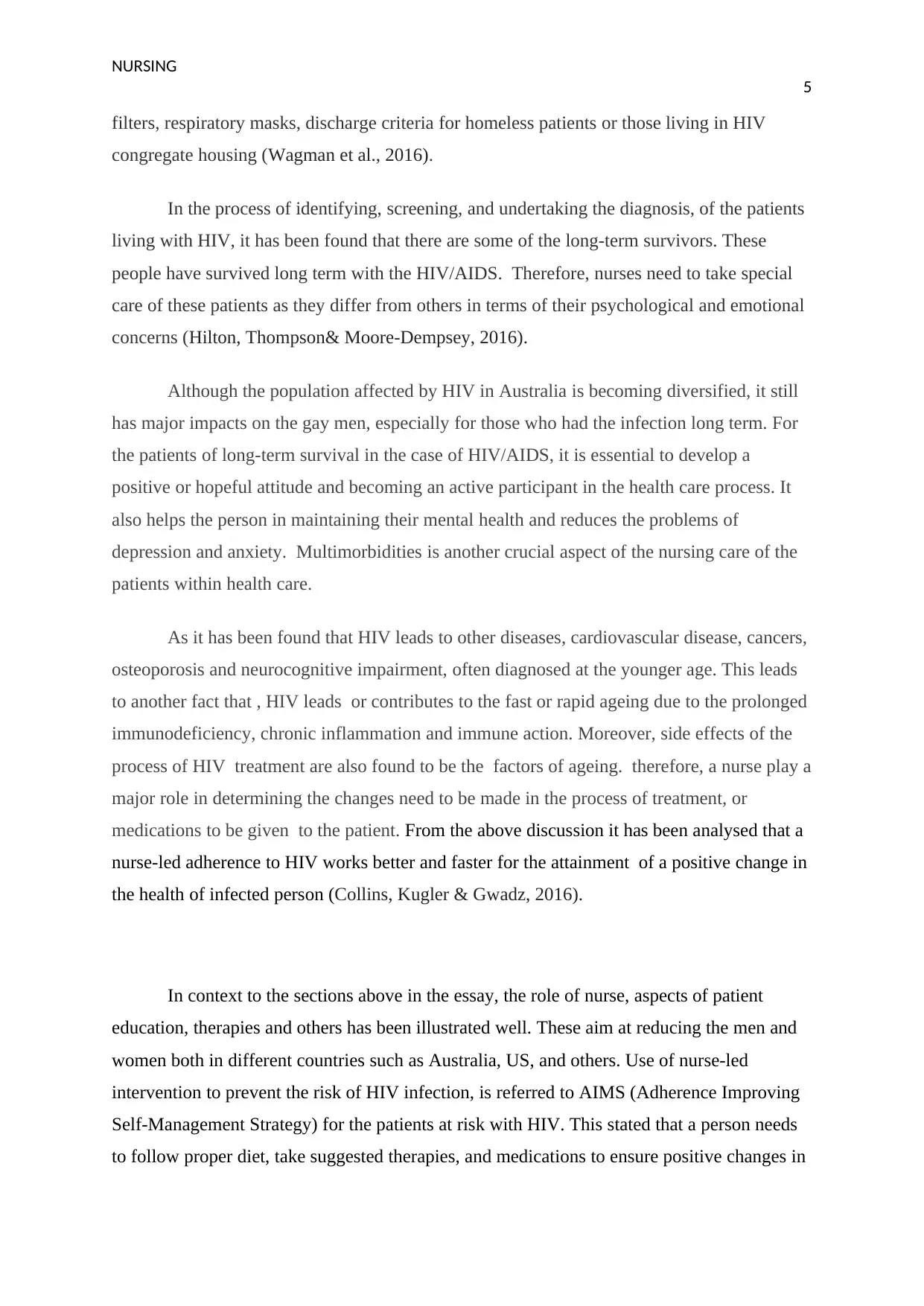
NURSING
5
filters, respiratory masks, discharge criteria for homeless patients or those living in HIV
congregate housing (Wagman et al., 2016).
In the process of identifying, screening, and undertaking the diagnosis, of the patients
living with HIV, it has been found that there are some of the long-term survivors. These
people have survived long term with the HIV/AIDS. Therefore, nurses need to take special
care of these patients as they differ from others in terms of their psychological and emotional
concerns (Hilton, Thompson& Moore-Dempsey, 2016).
Although the population affected by HIV in Australia is becoming diversified, it still
has major impacts on the gay men, especially for those who had the infection long term. For
the patients of long-term survival in the case of HIV/AIDS, it is essential to develop a
positive or hopeful attitude and becoming an active participant in the health care process. It
also helps the person in maintaining their mental health and reduces the problems of
depression and anxiety. Multimorbidities is another crucial aspect of the nursing care of the
patients within health care.
As it has been found that HIV leads to other diseases, cardiovascular disease, cancers,
osteoporosis and neurocognitive impairment, often diagnosed at the younger age. This leads
to another fact that , HIV leads or contributes to the fast or rapid ageing due to the prolonged
immunodeficiency, chronic inflammation and immune action. Moreover, side effects of the
process of HIV treatment are also found to be the factors of ageing. therefore, a nurse play a
major role in determining the changes need to be made in the process of treatment, or
medications to be given to the patient. From the above discussion it has been analysed that a
nurse-led adherence to HIV works better and faster for the attainment of a positive change in
the health of infected person (Collins, Kugler & Gwadz, 2016).
In context to the sections above in the essay, the role of nurse, aspects of patient
education, therapies and others has been illustrated well. These aim at reducing the men and
women both in different countries such as Australia, US, and others. Use of nurse-led
intervention to prevent the risk of HIV infection, is referred to AIMS (Adherence Improving
Self-Management Strategy) for the patients at risk with HIV. This stated that a person needs
to follow proper diet, take suggested therapies, and medications to ensure positive changes in
5
filters, respiratory masks, discharge criteria for homeless patients or those living in HIV
congregate housing (Wagman et al., 2016).
In the process of identifying, screening, and undertaking the diagnosis, of the patients
living with HIV, it has been found that there are some of the long-term survivors. These
people have survived long term with the HIV/AIDS. Therefore, nurses need to take special
care of these patients as they differ from others in terms of their psychological and emotional
concerns (Hilton, Thompson& Moore-Dempsey, 2016).
Although the population affected by HIV in Australia is becoming diversified, it still
has major impacts on the gay men, especially for those who had the infection long term. For
the patients of long-term survival in the case of HIV/AIDS, it is essential to develop a
positive or hopeful attitude and becoming an active participant in the health care process. It
also helps the person in maintaining their mental health and reduces the problems of
depression and anxiety. Multimorbidities is another crucial aspect of the nursing care of the
patients within health care.
As it has been found that HIV leads to other diseases, cardiovascular disease, cancers,
osteoporosis and neurocognitive impairment, often diagnosed at the younger age. This leads
to another fact that , HIV leads or contributes to the fast or rapid ageing due to the prolonged
immunodeficiency, chronic inflammation and immune action. Moreover, side effects of the
process of HIV treatment are also found to be the factors of ageing. therefore, a nurse play a
major role in determining the changes need to be made in the process of treatment, or
medications to be given to the patient. From the above discussion it has been analysed that a
nurse-led adherence to HIV works better and faster for the attainment of a positive change in
the health of infected person (Collins, Kugler & Gwadz, 2016).
In context to the sections above in the essay, the role of nurse, aspects of patient
education, therapies and others has been illustrated well. These aim at reducing the men and
women both in different countries such as Australia, US, and others. Use of nurse-led
intervention to prevent the risk of HIV infection, is referred to AIMS (Adherence Improving
Self-Management Strategy) for the patients at risk with HIV. This stated that a person needs
to follow proper diet, take suggested therapies, and medications to ensure positive changes in
⊘ This is a preview!⊘
Do you want full access?
Subscribe today to unlock all pages.

Trusted by 1+ million students worldwide
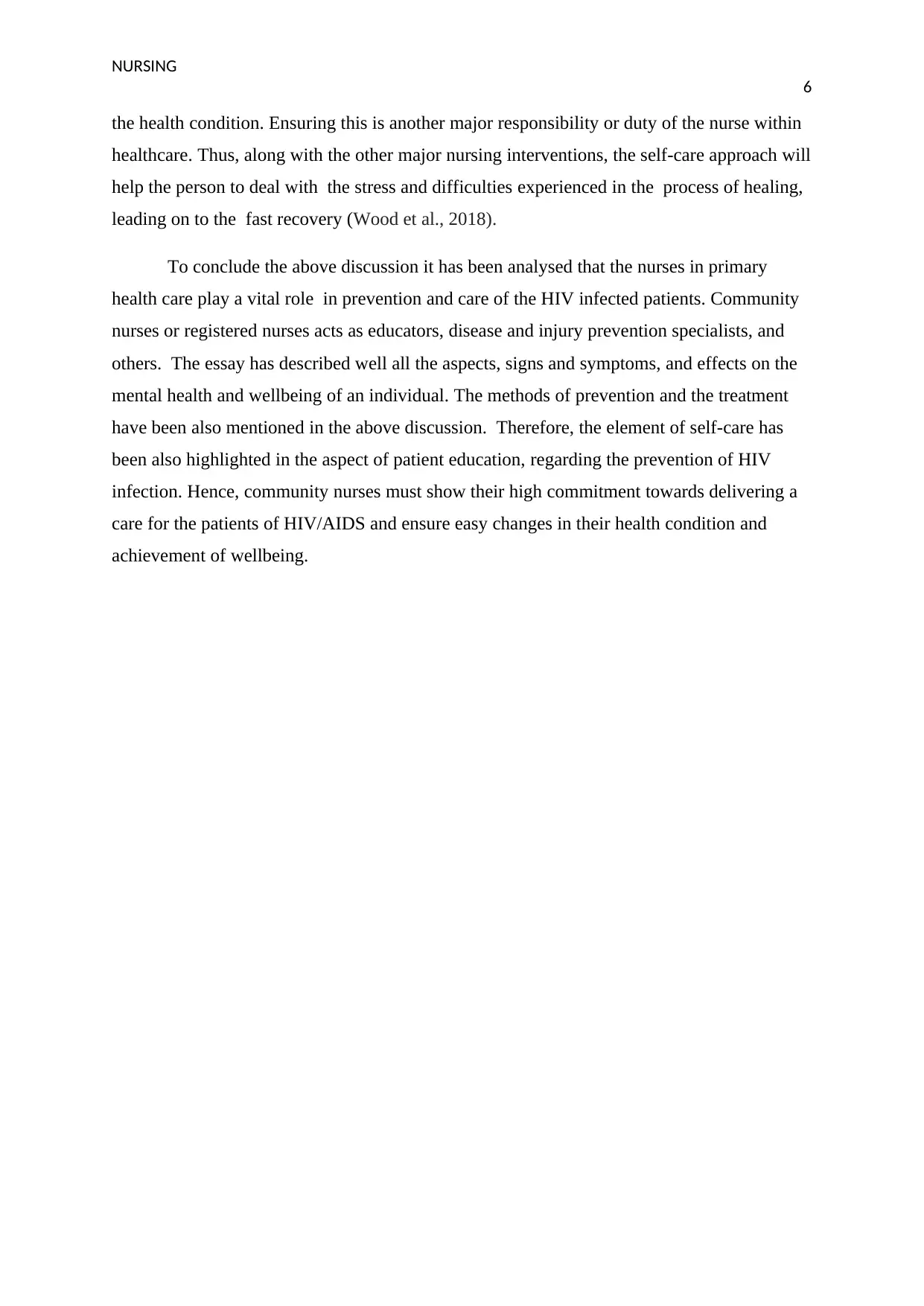
NURSING
6
the health condition. Ensuring this is another major responsibility or duty of the nurse within
healthcare. Thus, along with the other major nursing interventions, the self-care approach will
help the person to deal with the stress and difficulties experienced in the process of healing,
leading on to the fast recovery (Wood et al., 2018).
To conclude the above discussion it has been analysed that the nurses in primary
health care play a vital role in prevention and care of the HIV infected patients. Community
nurses or registered nurses acts as educators, disease and injury prevention specialists, and
others. The essay has described well all the aspects, signs and symptoms, and effects on the
mental health and wellbeing of an individual. The methods of prevention and the treatment
have been also mentioned in the above discussion. Therefore, the element of self-care has
been also highlighted in the aspect of patient education, regarding the prevention of HIV
infection. Hence, community nurses must show their high commitment towards delivering a
care for the patients of HIV/AIDS and ensure easy changes in their health condition and
achievement of wellbeing.
6
the health condition. Ensuring this is another major responsibility or duty of the nurse within
healthcare. Thus, along with the other major nursing interventions, the self-care approach will
help the person to deal with the stress and difficulties experienced in the process of healing,
leading on to the fast recovery (Wood et al., 2018).
To conclude the above discussion it has been analysed that the nurses in primary
health care play a vital role in prevention and care of the HIV infected patients. Community
nurses or registered nurses acts as educators, disease and injury prevention specialists, and
others. The essay has described well all the aspects, signs and symptoms, and effects on the
mental health and wellbeing of an individual. The methods of prevention and the treatment
have been also mentioned in the above discussion. Therefore, the element of self-care has
been also highlighted in the aspect of patient education, regarding the prevention of HIV
infection. Hence, community nurses must show their high commitment towards delivering a
care for the patients of HIV/AIDS and ensure easy changes in their health condition and
achievement of wellbeing.
Paraphrase This Document
Need a fresh take? Get an instant paraphrase of this document with our AI Paraphraser
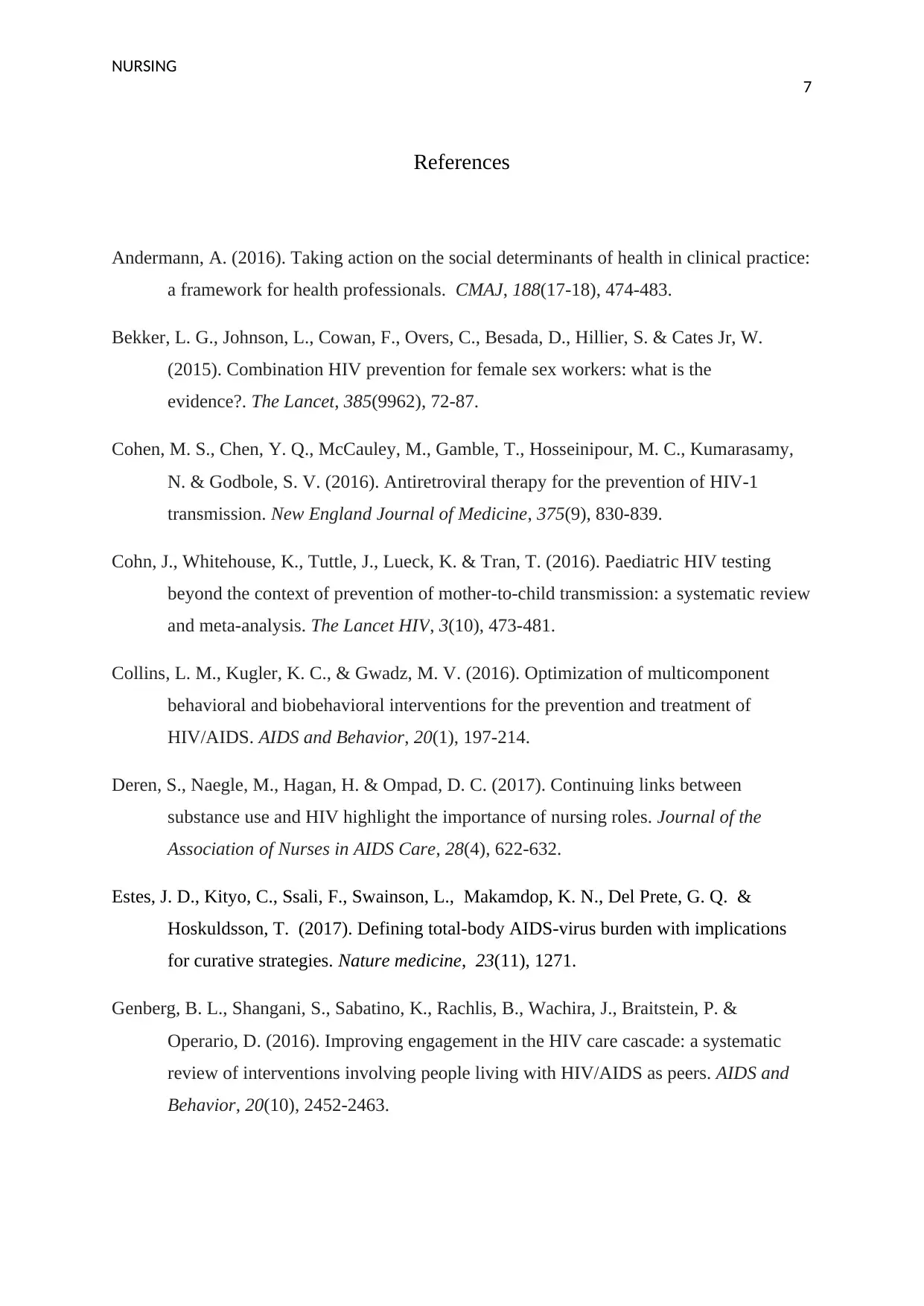
NURSING
7
References
Andermann, A. (2016). Taking action on the social determinants of health in clinical practice:
a framework for health professionals. CMAJ, 188(17-18), 474-483.
Bekker, L. G., Johnson, L., Cowan, F., Overs, C., Besada, D., Hillier, S. & Cates Jr, W.
(2015). Combination HIV prevention for female sex workers: what is the
evidence?. The Lancet, 385(9962), 72-87.
Cohen, M. S., Chen, Y. Q., McCauley, M., Gamble, T., Hosseinipour, M. C., Kumarasamy,
N. & Godbole, S. V. (2016). Antiretroviral therapy for the prevention of HIV-1
transmission. New England Journal of Medicine, 375(9), 830-839.
Cohn, J., Whitehouse, K., Tuttle, J., Lueck, K. & Tran, T. (2016). Paediatric HIV testing
beyond the context of prevention of mother-to-child transmission: a systematic review
and meta-analysis. The Lancet HIV, 3(10), 473-481.
Collins, L. M., Kugler, K. C., & Gwadz, M. V. (2016). Optimization of multicomponent
behavioral and biobehavioral interventions for the prevention and treatment of
HIV/AIDS. AIDS and Behavior, 20(1), 197-214.
Deren, S., Naegle, M., Hagan, H. & Ompad, D. C. (2017). Continuing links between
substance use and HIV highlight the importance of nursing roles. Journal of the
Association of Nurses in AIDS Care, 28(4), 622-632.
Estes, J. D., Kityo, C., Ssali, F., Swainson, L., Makamdop, K. N., Del Prete, G. Q. &
Hoskuldsson, T. (2017). Defining total-body AIDS-virus burden with implications
for curative strategies. Nature medicine, 23(11), 1271.
Genberg, B. L., Shangani, S., Sabatino, K., Rachlis, B., Wachira, J., Braitstein, P. &
Operario, D. (2016). Improving engagement in the HIV care cascade: a systematic
review of interventions involving people living with HIV/AIDS as peers. AIDS and
Behavior, 20(10), 2452-2463.
7
References
Andermann, A. (2016). Taking action on the social determinants of health in clinical practice:
a framework for health professionals. CMAJ, 188(17-18), 474-483.
Bekker, L. G., Johnson, L., Cowan, F., Overs, C., Besada, D., Hillier, S. & Cates Jr, W.
(2015). Combination HIV prevention for female sex workers: what is the
evidence?. The Lancet, 385(9962), 72-87.
Cohen, M. S., Chen, Y. Q., McCauley, M., Gamble, T., Hosseinipour, M. C., Kumarasamy,
N. & Godbole, S. V. (2016). Antiretroviral therapy for the prevention of HIV-1
transmission. New England Journal of Medicine, 375(9), 830-839.
Cohn, J., Whitehouse, K., Tuttle, J., Lueck, K. & Tran, T. (2016). Paediatric HIV testing
beyond the context of prevention of mother-to-child transmission: a systematic review
and meta-analysis. The Lancet HIV, 3(10), 473-481.
Collins, L. M., Kugler, K. C., & Gwadz, M. V. (2016). Optimization of multicomponent
behavioral and biobehavioral interventions for the prevention and treatment of
HIV/AIDS. AIDS and Behavior, 20(1), 197-214.
Deren, S., Naegle, M., Hagan, H. & Ompad, D. C. (2017). Continuing links between
substance use and HIV highlight the importance of nursing roles. Journal of the
Association of Nurses in AIDS Care, 28(4), 622-632.
Estes, J. D., Kityo, C., Ssali, F., Swainson, L., Makamdop, K. N., Del Prete, G. Q. &
Hoskuldsson, T. (2017). Defining total-body AIDS-virus burden with implications
for curative strategies. Nature medicine, 23(11), 1271.
Genberg, B. L., Shangani, S., Sabatino, K., Rachlis, B., Wachira, J., Braitstein, P. &
Operario, D. (2016). Improving engagement in the HIV care cascade: a systematic
review of interventions involving people living with HIV/AIDS as peers. AIDS and
Behavior, 20(10), 2452-2463.
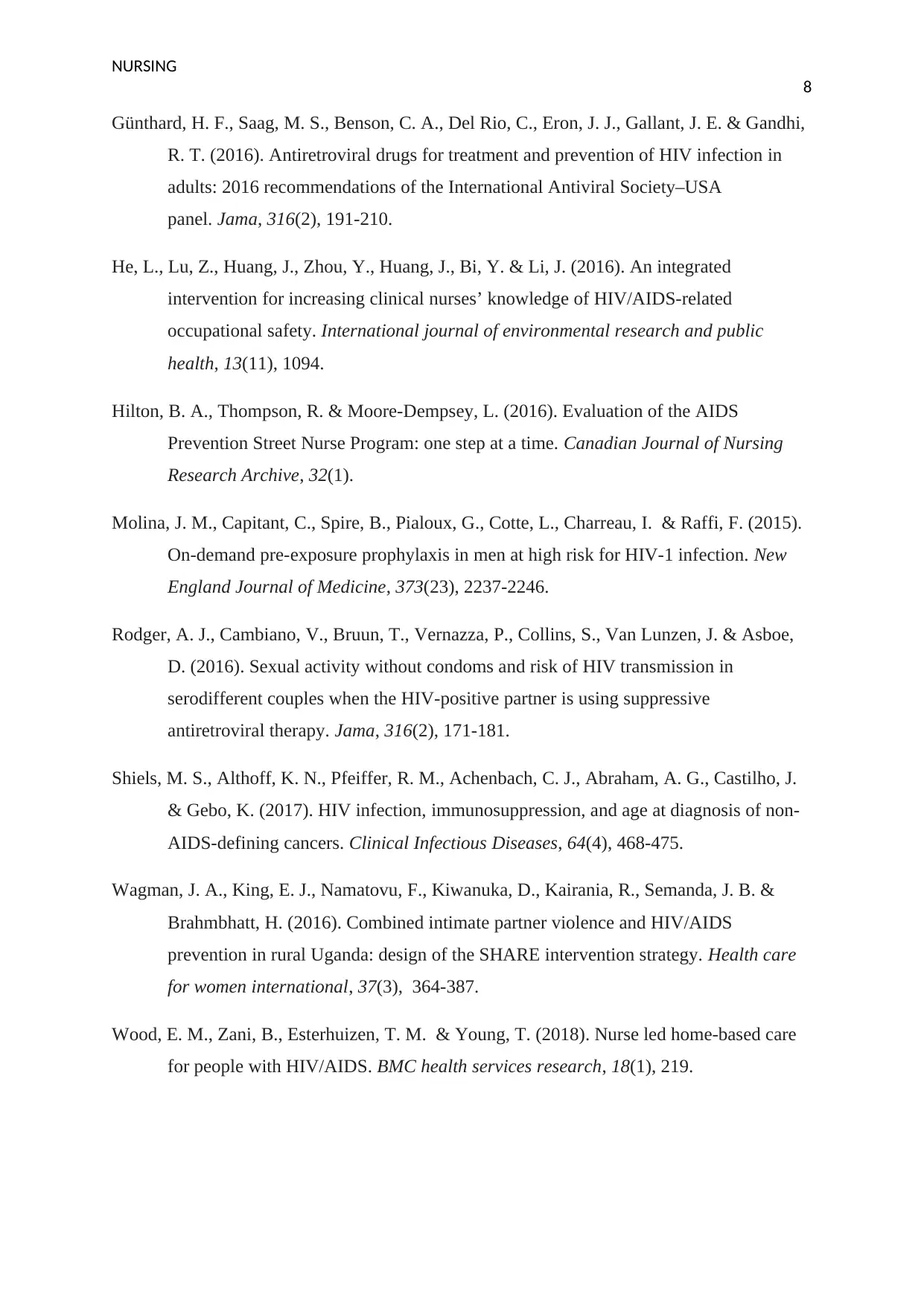
NURSING
8
Günthard, H. F., Saag, M. S., Benson, C. A., Del Rio, C., Eron, J. J., Gallant, J. E. & Gandhi,
R. T. (2016). Antiretroviral drugs for treatment and prevention of HIV infection in
adults: 2016 recommendations of the International Antiviral Society–USA
panel. Jama, 316(2), 191-210.
He, L., Lu, Z., Huang, J., Zhou, Y., Huang, J., Bi, Y. & Li, J. (2016). An integrated
intervention for increasing clinical nurses’ knowledge of HIV/AIDS-related
occupational safety. International journal of environmental research and public
health, 13(11), 1094.
Hilton, B. A., Thompson, R. & Moore-Dempsey, L. (2016). Evaluation of the AIDS
Prevention Street Nurse Program: one step at a time. Canadian Journal of Nursing
Research Archive, 32(1).
Molina, J. M., Capitant, C., Spire, B., Pialoux, G., Cotte, L., Charreau, I. & Raffi, F. (2015).
On-demand pre-exposure prophylaxis in men at high risk for HIV-1 infection. New
England Journal of Medicine, 373(23), 2237-2246.
Rodger, A. J., Cambiano, V., Bruun, T., Vernazza, P., Collins, S., Van Lunzen, J. & Asboe,
D. (2016). Sexual activity without condoms and risk of HIV transmission in
serodifferent couples when the HIV-positive partner is using suppressive
antiretroviral therapy. Jama, 316(2), 171-181.
Shiels, M. S., Althoff, K. N., Pfeiffer, R. M., Achenbach, C. J., Abraham, A. G., Castilho, J.
& Gebo, K. (2017). HIV infection, immunosuppression, and age at diagnosis of non-
AIDS-defining cancers. Clinical Infectious Diseases, 64(4), 468-475.
Wagman, J. A., King, E. J., Namatovu, F., Kiwanuka, D., Kairania, R., Semanda, J. B. &
Brahmbhatt, H. (2016). Combined intimate partner violence and HIV/AIDS
prevention in rural Uganda: design of the SHARE intervention strategy. Health care
for women international, 37(3), 364-387.
Wood, E. M., Zani, B., Esterhuizen, T. M. & Young, T. (2018). Nurse led home-based care
for people with HIV/AIDS. BMC health services research, 18(1), 219.
8
Günthard, H. F., Saag, M. S., Benson, C. A., Del Rio, C., Eron, J. J., Gallant, J. E. & Gandhi,
R. T. (2016). Antiretroviral drugs for treatment and prevention of HIV infection in
adults: 2016 recommendations of the International Antiviral Society–USA
panel. Jama, 316(2), 191-210.
He, L., Lu, Z., Huang, J., Zhou, Y., Huang, J., Bi, Y. & Li, J. (2016). An integrated
intervention for increasing clinical nurses’ knowledge of HIV/AIDS-related
occupational safety. International journal of environmental research and public
health, 13(11), 1094.
Hilton, B. A., Thompson, R. & Moore-Dempsey, L. (2016). Evaluation of the AIDS
Prevention Street Nurse Program: one step at a time. Canadian Journal of Nursing
Research Archive, 32(1).
Molina, J. M., Capitant, C., Spire, B., Pialoux, G., Cotte, L., Charreau, I. & Raffi, F. (2015).
On-demand pre-exposure prophylaxis in men at high risk for HIV-1 infection. New
England Journal of Medicine, 373(23), 2237-2246.
Rodger, A. J., Cambiano, V., Bruun, T., Vernazza, P., Collins, S., Van Lunzen, J. & Asboe,
D. (2016). Sexual activity without condoms and risk of HIV transmission in
serodifferent couples when the HIV-positive partner is using suppressive
antiretroviral therapy. Jama, 316(2), 171-181.
Shiels, M. S., Althoff, K. N., Pfeiffer, R. M., Achenbach, C. J., Abraham, A. G., Castilho, J.
& Gebo, K. (2017). HIV infection, immunosuppression, and age at diagnosis of non-
AIDS-defining cancers. Clinical Infectious Diseases, 64(4), 468-475.
Wagman, J. A., King, E. J., Namatovu, F., Kiwanuka, D., Kairania, R., Semanda, J. B. &
Brahmbhatt, H. (2016). Combined intimate partner violence and HIV/AIDS
prevention in rural Uganda: design of the SHARE intervention strategy. Health care
for women international, 37(3), 364-387.
Wood, E. M., Zani, B., Esterhuizen, T. M. & Young, T. (2018). Nurse led home-based care
for people with HIV/AIDS. BMC health services research, 18(1), 219.
⊘ This is a preview!⊘
Do you want full access?
Subscribe today to unlock all pages.

Trusted by 1+ million students worldwide
1 out of 9
Related Documents
Your All-in-One AI-Powered Toolkit for Academic Success.
+13062052269
info@desklib.com
Available 24*7 on WhatsApp / Email
![[object Object]](/_next/static/media/star-bottom.7253800d.svg)
Unlock your academic potential
Copyright © 2020–2026 A2Z Services. All Rights Reserved. Developed and managed by ZUCOL.





